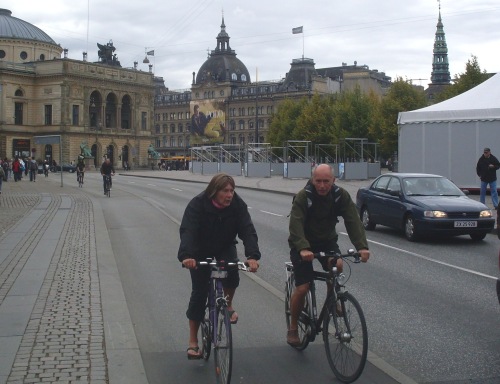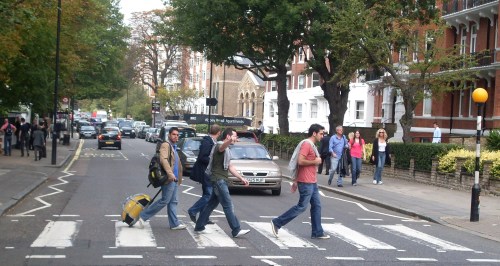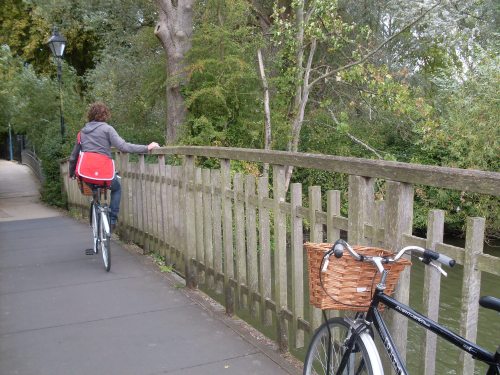Here is a special treat for you. A friend of mine has just returned from a working European Vacation and has lodged a report of his cycling experiences for you to enjoy. Greg does lots of really smart brainy stuff with computers and social thingy whatsits, that I’m not quite sure about. He also runs the great music label Spill. Without further ado……..
Biking in Europe, from your foreign correspondent Greg Wadley
I just wound up a month-long working holiday in Europe during which I biked in a number of cities, for commuting and sight-seeing. I’ll compare the bike experience in these places to Melbourne and to each other.
Denmark

Top billing for biking goes to Denmark. Bikes rule in this country, and the Danes seem to be better off for it, as they are a healthy, happy lot who’ve maintained a pleasant environment while so many countries lost theirs. I biked in two cities and spent a week working in a smaller town, where I had no bike access but got the general idea by looking. Copenhagen is where Melbourne got the idea for its experimental ‘Copenhagen lanes’. They don’t call them this in Copenhagen but they are on just about every street – certainly all the main ones. Unlike on Swanston Street, there’s no ‘traffic island’ separating them from cars, but they are clearly distinguished from both the car and pedestrian lanes, and woe betide the car or pedestrian who strays into them. Cyclists ride with confidence and righteousness – there’s no “please mister car driver will you let me drive on your road” in Denmark – and it’s a normal mode of transport for people of all ages. Danish cyclists are not afraid of commuting long distances (compared to what I’m used to), and they don’t have to worry about aggression or stupidity from car drivers, as car-on-bike violence is simply not part of the culture. It’s kind of a law-abiding, respectful society anyway. My hotel rents bikes to its guests (something I’ve never seen outside Europe) so I used a bike to explore the city and go to work. Something Australian governments need to figure out is that whenever someone rides instead of driving, everyone benefits, so it’s logical to support and subsidize cycling rather than punish it. A lot of the problems of big cities are eased with this one step.

I spent two days in Aarhus, “capital of Jutland” and Denmark’s second city. It’s the same story for bike lanes here – they are on most roads, and are not de-facto car-parking or turning lanes as they are in Australia. Here I got to try the famous coin-operated “City-Bikes”. These are great – you just walk up to a bike rack (there are several scattered throughout the city), pop in a coin (equivalent to a few Australian dollars), the lock pops open and you ride away. When you’re done you can return it to a rack and get your coin back, or leave it in any public place and someone will return it for you and keep the coin. What a great system. They are crappy no-gear bikes, but are fine for getting round town, and offer fuss-free cycling for occasional users or visitors. Again, the fact that Danes are respectful allows this system to work, and the city is happy to supply or subsidize the bikes as it is for the common good.
I also spent a week in Roskilde working at the local university. The campus is a long way from town and most students train there, either from Roskilde or in most cases from Copenhagen, which is 20 minutes away. Bike culture was less obvious in this small town but even so there were distinct bike lanes on the main roads.
Berlin and Vienna


Second place goes to these two German-speaking capitals. They don’t feature the separate bike lanes that Denmark has, and this makes a noticeable difference, as cyclists have to share car lanes, with all the dangers this implies. But cycling still is a majority habit and doesn’t suffer from the “ratbags and losers” image it has in most of the Anglo world. Both my three-star Viennese hotel and my low-rent Berlin hostel rent bikes to visitors. If you are ever touristing and have only a few days to explore a city, bikes are the winning way to get around. It’s faster than walking and easier than learning a new public transport system. Berlin has nice trams but I had limited time so I biked and saw quite a lot. I was in Vienna a week and did a bit of both (biking and tramming). A nice ride in Vienna is up and down the DonauKanal bike paths – see accompanying photo. The InnerStadt, where most of the tourist destinations are (grand palaces, shops, art galleries etc) is a maze of cobblestone lanes and you can really only walk or ride there. Despite this, some asses try to drive on them and it is immediately obvious to the visitor that Vienna should ban cars from InnerStadt.
England

The old dart is a mixed bag for cyclists. Inner London is crazy busy and I didn’t see many people riding, nor find a rental or bike shop. I was only there a few days, so longer-term residents might give a more complete picture. This is the loudest city I’ve experienced – even louder than NYC I think. The streets are mostly narrow and lined on both sides with old medium-rise buildings, like you see all over Europe. This makes vehicle noise echo up and down the street, more so than in Australian cities, so that if you’re conversing on the footpath you have to shout. This makes it unpleasant to be on the street – unless you’re inside a vehicle, setting up the same catch-22 that plagues American and Australian cities. Still, if you could find a bike and were willing to brave the traffic, you could see a lot of classic scenery quite quickly.

I spent two days in Oxford with a cyclist colleague and we were able to find a bike rental store near the “covered market” in town. Oxford is classically beautiful, with ancient University buildings, picturesque river paths and some not-so-old suburbs that are worth a look. Again, you can see all this stuff by PT or on foot, but if you have limited time, a bike will take you more places more quickly. It’s good for exploring because if you take the wrong path you can quickly double back without the tedium of walking lost, up and down streets. The only bad bits are, of course, busy roads, where cars make life dangerous and annoying for everyone else, as they do in most parts of the world.
I also had two days in Manchester, which is kind of a cross between these two. The bit I was in was mighty ugly-urban, and I didn’t see many bikes or evidence of a cycling culture (eg shops or rentals). Still, if you found one, and were willing to brave the frustrated car-drivers, you could see more, quickly.
Lessons learned
Seeing a range of bike-friendliness across several cities in one month allowed me to learn things from the comparison.
• Biking improves a city’s quality of life, not just for those who do it but for everyone else too, by reducing clutter, noise, and pollution.
• Bikes and cars don’t really co-exist, and the only real solution is to put them in separate lanes. Denmark, the alpha biking country, does this. The relative anonymity and ‘social distance’ afforded by the car’s little metal box brings out the worst in people. Drivers are frustrated because there are so many of them that they can’t drive quickly or park. Unfortunately they are anonymous cowards too, and take it out on cyclists and pedestrians rather than each other. Fence them off and tax them to pay for it.
• Helmets are not compulsory in any European city. I noticed about a third of people use them voluntarily. Let’s face it, these are forced on Melbournian cyclists not to protect them but to imply that damage done to cyclists by car drivers is the responsibility of the cyclist, and to inconvenience and humiliate cyclists so that commuters will choose cars instead. Cities that are serious about promoting cycling makes helmets voluntary.
Yep, bike riding in Europe beats bike riding in Melbourne hands down. I was in heaven when I rode around Amsterdam a couple of years back!
I fully agree on the unintended negative effect of compulsory helmets. Recently a local council pamphlet (Brisbane Australia) showed two trendy cyclists in suits, one male, one female cycling WITHOUT helmets, as if showing them in helmets might make them look less sexy. Well, they are right. A pear shaped block of plastic will never be a fashion accessory to the average city worker. I prefer to wear a hat for shade; the cycling helmet doesn’t offer much of that either, although I have modified mine with bits and pieces held on with gaffer tape.. Hmmm, hot!
Something I forgot until I got back: I didn’t see any ‘lycra heroes’ in Europe. People just ride around in their normal clothes. I’ve never understood why so many Australian cyclists feel the need to wear racing gear and ride as fast as they can when they’re just commuting. After all, the simplicity of getting about is part of the allure of biking, and that disappears if you have to change your clothes at each end of the journey. My guesses: 1. They’re motivating themselves by pretending they’re winning the Olympics. 2. The compulsory dorky helmet half-ruins the ease of use already so they might as well go the whole hog and get lycra on. 3. They have internalized “I’m tougher than you because my car goes fast” and are over-compensating by trying to look tougher than other cyclists.
H1
When I was last in Berlin (mostly in the former east, Mitte and Prenzlauerberg), I noticed that the pavements were divided into two paths: a footpath and, divided from it by a median, a cycle path adjoining the kerb (but not on the road). And Berlin, at all times of the day and night, is full of cyclists.
Good point ACB, I saw those too but forgot to mention them in the post. I didn’t realize what these lanes were at first. Some of the footpaths where I was (corner Schoenhauser and Danziger streets in Prenzlauerberg) were divided into “smooth lanes” and “cobblestone lanes”. I used the smooth lanes to wheel my suitcase – until I found out, pretty quickly, that they were bike lanes. They didn’t seem to be marked – are they ‘official’ bike lanes or is it a custom?
ACB has a link to a relevant article in the Independent on Danish cycling, at his blog .. http://dev.null.org/blog/item/200910192343_whatworlc .. the article is quite good and not just about cycling
Nice to read this. But as a Melbourne boy now living in Amsterdam I’m naturally offended that this city of the bike missed out!
We were in Denmark riding last year, though, and agree Copenhagen was excellent…and the Danish island Bornholm was brilliant (see link below)
Cheers mate!
Richard
http://richardtulloch.wordpress.com/2009/11/02/colour-clash-cycling-denmarks-bornholm-island/
I ran onto this blog by accident. but I have a small thing to add.
Personally I’m Dutch, does this mean I cycle a lot? Well yes, yes it does. In average about an hour a day so in my life that must have been ehm about 7000 hours of experience or so. Recently, about 6 Months ago, I moved to Denmark, under the impression that this would be a good cyclist country. Naturally, I compared it to the Netherlands, and some things were striking. First of, the system is much more dangerous. There are countries that view cyclists as a special kind of cars, and there are countries that view cyclists as a special kind of pedestrians. Denmark is one of the last ones, but has fitted its infrastructure accordingly. It is a menace. But I could write about it for days. If you like cycling, go to the Netherlands. That is really the only country in the world. Where cyclists are before cars. And not the other way around.